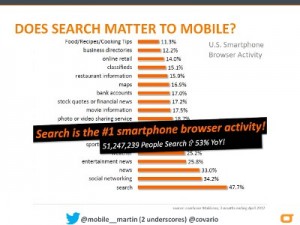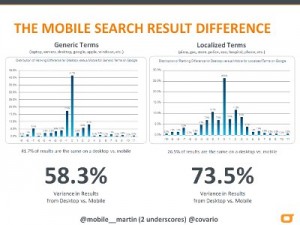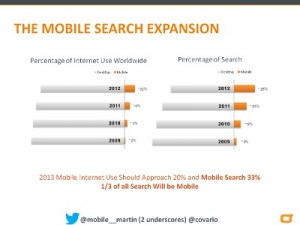Recent announcements from Google like: New Hummingbird algorithm update (which noticeably shows connections to voice search queries submitted from mobile devices) and other updates: Google PageSpeed Tool for analysis of mobile-specific page; alteration in Google SERP layout for Mobile devices; or inclusion of load-time in the mobile search algorithm clearly indicates an era of Mobile already captured the current SEO as Mobile SEO.
“Mobile is probably growing faster than anyone in the room expects,” said Google’s Distinguished Engineer Matt Cutts at SES San Francisco in September. “Mobile traffic to Google will surpass desktop traffic to Google pretty soon – not in weeks or a few months, but soon.”Also recent practices show that Mobile traffic will surpass desktop traffic in coming days. To remain in the search contention it is the time to strategize SEO Strategies which focus more on mobile searches than desktop searches.
Modification in SEO Strategies – An Impact of Mobile Usage
According to the current survey available on Wikipedia shows that in near future the number of mobile devices will exceed the number of people on the planet; i.e. usage of mobile devices exceed the usage of desktop.
Mobile Search versus Desktop Search:
Now it is more challenging for marketers and brand leaders to strategize content so that it can be easily available and engage searchers using mobile device as compared to desktop.
Additionally Mobile users prefer conversational or voice search rather than text search.
Does Mobile Search Really Exist?
According to comScore, Search is, in fact, the #1 activity on mobile browser. Most of the contribution goes to to Android’s dominance,

So, now we can affirm that search is a heavy activity on mobile devices; but, how much?
Mobile Search: A leading Search Activity
It was observed that usage of mobile Internet increases to just over 10% of total Internet use in 2012, but in 2013 mobile search increases to over 25% of all search worldwide.
We can see that mobile searching is happening and increasing; but, isn’t it the same as desktop search?
Difference between Mobile & Desktop Search Results:
Below data shows rank differences between mobile (Smartphone) results and desktop results. It indicates that Generic terms resulted in over a 50% difference, while local terms had nearly a 75% variance in mobile and desktop search result rankings.
Five ways Brands and Agencies can start Benefitting of this mobile trend in Search (SEO):
1. SEO Strategies for Content Marketing:
If we have to move forward with current SEO and content marketing strategy then mobile search should be taken into consideration for keyword research and conversion measurement.
Before thinking of initiating an SEO or content marketing strategy, be sure about how the service provider going to account for the trends in mobile organic search behavior, and measure discoverability and engagement of content on a desktop device versus a mobile device.
2. Keyword Research and Tracking
“(Not provided)” and “(not set)” have made keyword performance tracking much more challenging. Whether the search is executed from a mobile device (text or voice) or a desktop device (text or voice), it needs to be monitored for discoverability and position change as a searcher’s behavior varies greatly depending on, use of more keywords. It helps to understand which content asset is potentially being discovered for a grouping of similar keywords.
Groupings of like keywords are key. For example:
Mobile shop
Mobile store
Mobile shop Los Angeles
Mobile store Los Angeles
Mobile shop in Los Angeles
Mobile store in Los Angeles
I am looking for a mobile shop
I am looking for a mobile store
I am looking for a mobile shop in Los Angeles
I am looking for a mobile store in Los Angeles
3. Mobile Segments Tracking in Google Analytics
To understand the actions of your visitors from mobile device and engagement with content and your brand and how it differs from a desktop can be tracked with the feature of mobile segments in Google Analytics.
You can choose from built-in segments in Google Analytics: “Mobile Traffic”, “Mobile and Tablet Traffic” and “Tablet and Desktop Traffic”, but to analyse the behavior of only desktop users, you will need to create a new segment:
- Click on the arrow at the top left of your Google Analytics Overview screen to open the Segment Builder.
- Click on the “+ Create New Segment” button at the top left.
- Click on “Technology” in the left menu bar.
- Scroll down to “Device Category” and select “exactly matches” and “desktop”.
- Enter the “Segment Name” at the top (e.g., Desktop Traffic).
- Click Save.
After completing above steps you can pick both the mobile and the desktop segments to gain insight into the conversion rate differences between visitors from each source (e.g., Conversion of Time on Page or Number of Pages Visited), and then you can take appropriate actions to improve your website content.
4. Measuring Web Presence in Analytics: Page-Level and Content-Level
Reporting on the engagement, performance, and discoverability of content, and understanding where optimization opportunities exist, requires content-level or web page-level analytics. These metrics include page-specific backlinks, social signals, and conversions.
To track, select the Mobile Traffic and Desktop Traffic segments again in Analytics (as defined above), it will help to determine whether your content is converting higher on mobile or desktop, and then find the reason accordingly.
Check keywords ranking at the content level to track the behaviour of keywords added in the content, and find opportunities to improve the content for further optimization, discoverability, and engagement.
5. Human Factors of Optimization
It is mandatory to observe the data and metrics across different devices: mobile and desktop; which serve a key factor in engaging human being and to improve brand presence.
It is an essential step to study how people interact with the brand’s presence from different devices and what keywords are used by them to search the brand. It will help to know more about the behaviour of human nature and to optimize the website to gain more brand presence.
References:
http://searchengineland.com/4-mobile-search-trends-tackled-at-smx-west-2013-151657
http://searchenginewatch.com/article/2296378/3-Essentials-for-Great-Mobile-SEO








Thanks for this amazing post! I agree with you and google is pushing towards mobile seo so that user can find you anywhere at any point of time.